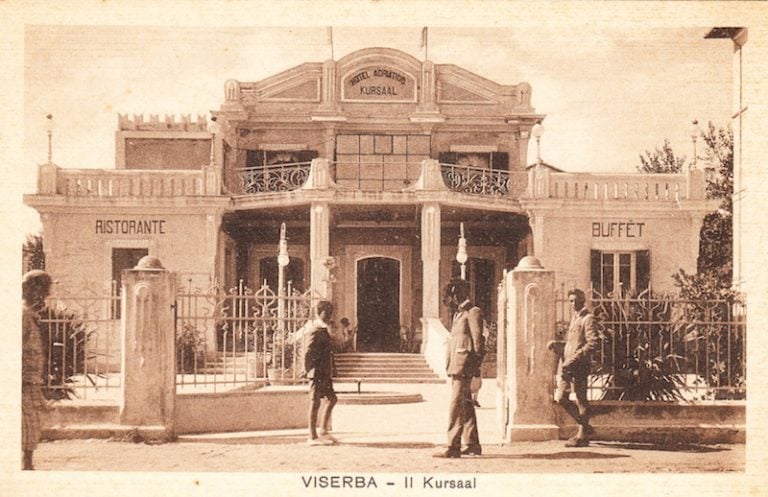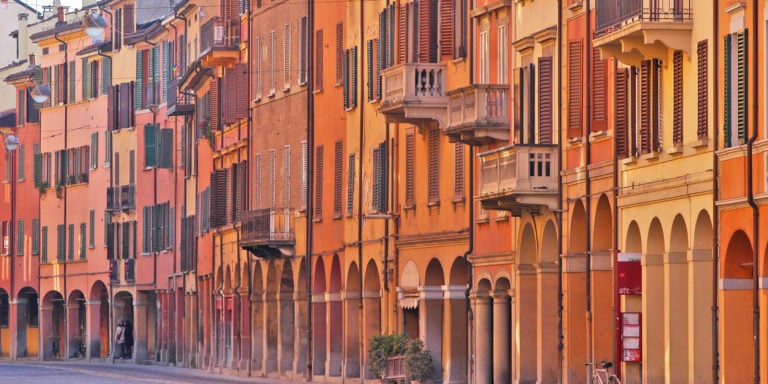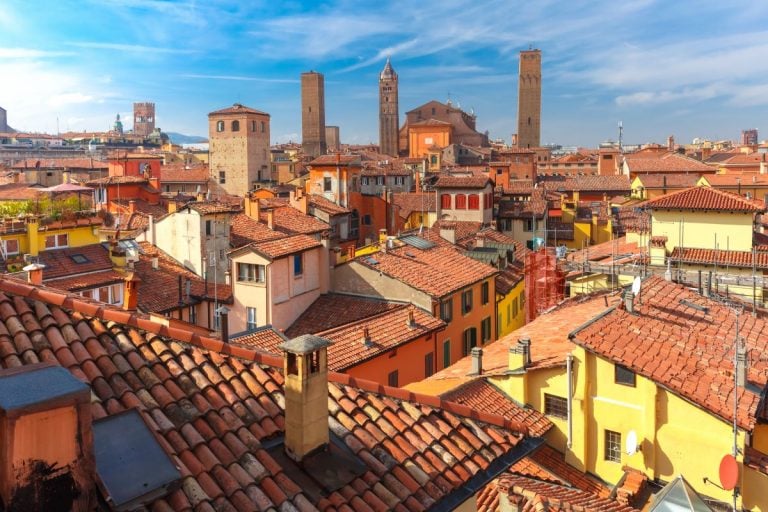We all know it for its mediaeval soul, especially for its towers and crenellated palaces that have silently watched over the city centre for centuries. However, at a closer look Bologna has plenty of buildings dating back to more modern times. Let’s go back then to the early 20th century to embark on a journey through the Art Nouveau style in Bologna, and discover the many traces it has left behind both in the streets of the centre and in the suburbs.
What came before the advent of Art Nouveau was a time of major urban development for the city. Following the Unification of Italy, new avenues were created in Bologna – think of Via dell’Indipendenza and the Via Irnerio-dei Mille-Don Minzoni axis – while others were expanded, such as the central Via Rizzoli.
Then, in 1889, the city council approved the Town Planning and Extension Plan, which included the creation of new districts outside the 14th-century walls. The latter were to be demolished starting in 1902, making way for the future ring roads that now embrace the historic centre.
It was in this profoundly changing context that the highly decorative and nature-inspired European art movement known as Art Nouveau was established in the city.
1. Palazzo Ronzani and Cinema Modernissimo
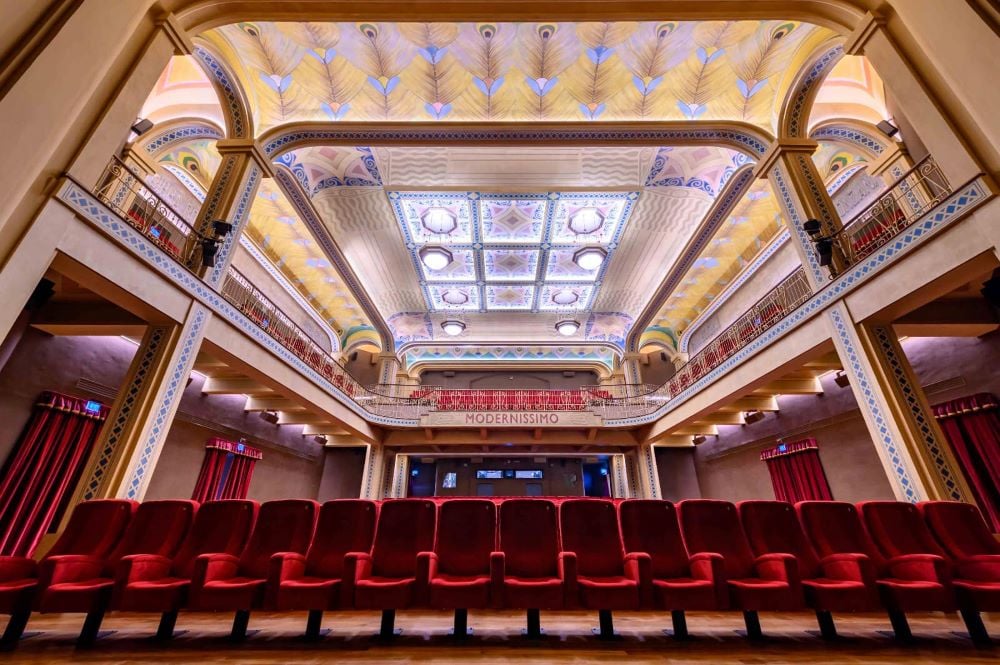
Let’s begin our tour of Art Nouveau architecture in Bologna with a building on the corner of Via Rizzoli and Piazza Re Enzo that holds some interesting surprises.
Opened in 1914 at the wish of an entrepreneur working in the brewing industry, Palazzo Ronzani is an imposing late Art Nouveau building designed by Ettore Lambertini and Gualtiero Pontoni on the former site of the Mercato di Mezzo market. It is fairly easy to recognise it if you’re walking on Via Rizzoli: just look for its angular façade topped by a turret and the colourful iron and glass canopy that indicates the presence of an old tram stop.
As we approach the arcade of the building, we then notice a rare example of an Art Nouveau shop, the former Profumeria Goselli, which today houses a jewellery shop. Peering through its windows, we can still see the wonderful original furnishings and chandeliers designed by architect Paolo Sironi (1914).
This is not the only treasure in Palazzo Ronzani. The project also included the construction of a two-storey underground theatre, which was converted into a cinema shortly afterwards. It remained in operation until 2007 under the name Cinema Arlecchino, then closed for a long time until the city decided to bring the hall – finely decorated with Art Nouveau frescoes – back to life and give it back to the people of Bologna under its original name, Cinema Modernissimo.
2. Casa Barilli
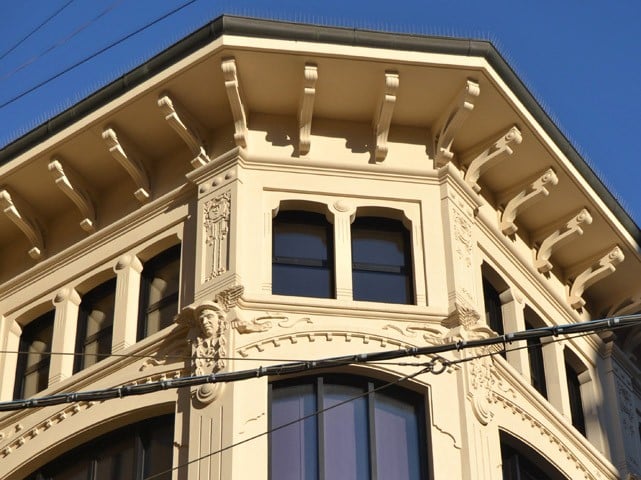
We are not joking when we say that Bologna’s centre is full of traces of a recent past! For the second stop on our Art Nouveau tour of Bologna, simply cross the street and look up at a recently renovated palazzo, home to a well-known US tech brand.
Like Palazzo Ronzani, Casa Barilli is a corner building facing Via Rizzoli. Yet, its construction dates back to a few years earlier, precisely 1906-1907, designed by architect Leonida Bertolazzi.
Casa Barilli was built with the intention of housing Bologna’s first department store, which is easy to guess given the large windows that line the entire façade. Set out on four floors, its decorations of lowered arches, wrought iron railings and full-height pilasters recall the style of the Viennese Secession, while conveying a sense of timeless elegance.
3. Salaborsa Library
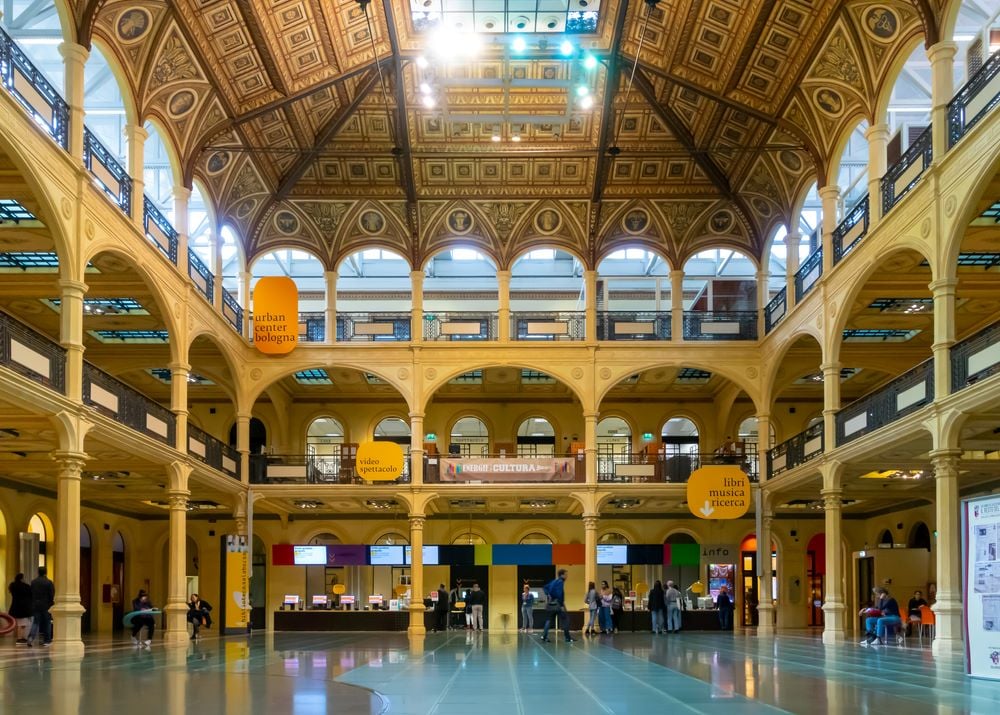
Salaborsa is a landmark in the history of the city, but also an unmissable destination for visitors. Now a public library and a venue for meetings and presentations, the original core of the building was built in the 1880s and underwent some structural changes in the 1920s.
The traces of its long history are clearly visible beneath the glass pavement of the so-called ‘covered square’, which houses the remains of Roman and mediaeval Bologna, as well as traces of the 16th-century Botanical Garden. Over time, Salaborsa changed several uses – from stock market trading to a bank and even a sports hall – before becoming one of Bologna’s best-known libraries.
As for the architecture of the building, the inner square of the Salaborsa is surrounded by slender arches resting on cast iron columns, which in turn support a luminous glass and metal roof. Designed in the modernist style, the extensive use of iron hints at the Art Nouveau movement that would arrive in the city only a few years later, as do the ceiling rose decorations.
4. Palazzina Majani
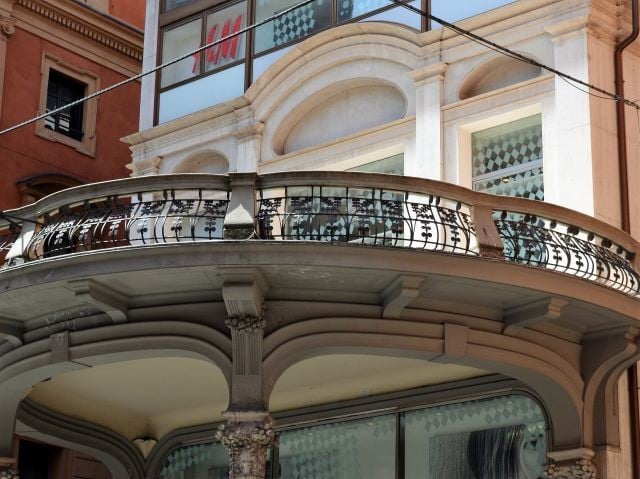
Let’s now walk just a few metres from Salaborsa to Palazzina Majani, located on Via Indipendenza. The history of this building is inextricably linked with that of the famous chocolatier family – the first in Italy to create chocolate in solid form – who once had their headquarters here, a stone’s throw from Piazza Maggiore.
With its semi-circular balcony, wrought-iron balustrade, floral decorations and fruit festoons adorning the capitals of the portico, Palazzina Majani is an excellent example of Art Nouveau architecture in Bologna. Because of its unusual shape, and reflecting the influence of Art Nouveau on it, purists used to compare the palazzina to ‘a Vienna chair’.
Built by the painter and architect Augusto Sezanne, from the year of its opening (1904) until 1953 the building was home to a fine bar, a tea room and of course Majani’s chocolate and confectionery shop. The outdoor terrace, on the other hand, housed a few tables and a space for live music and dancing, also popular with celebrities visiting the city.
5. Via Audinot and the Villino Civilisation
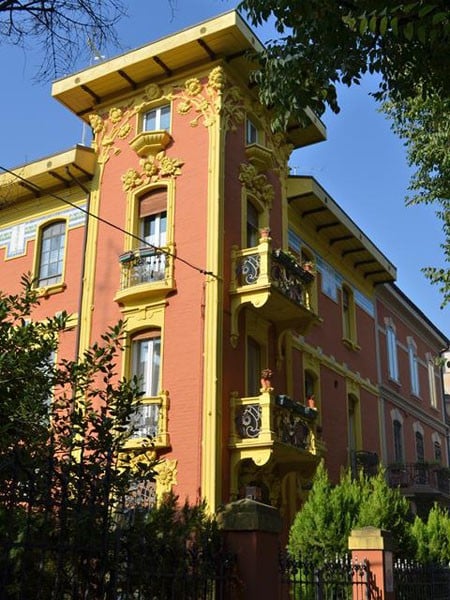
Do you remember the urban development plan we mentioned in the introduction to this article? One of the most obvious consequences of this ambitious late 19th-century urban planning project was the creation of the so-called garden city outside Porta Saragozza, a fascinating example of Art Nouveau in Bologna.
In the area of today’s Via Audinot street, several Art Nouveau villas were built to accommodate the city’s bourgeois class, who were looking for a more appropriate accommodation than the old and partly decaying buildings in the city centre. This phenomenon was later defined as the ‘villino civilisation’.
The project was entrusted to architect Paolo Sironi in the early 20th century, who designed a series of charming buildings, often topped by turrets and surrounded by greenery, equipped with balconies, gates, windows and doors finely worked with plant and geometric motifs, or real painted motifs and ceramics.
Further Evidence of the Art Nouveau Style in Bologna
The centre and the outskirts of Bologna boast further traces of the so-called floral style. Here are some of them:
- Canton de Fiori
- Lamppost in Piazza Nettuno
- Ex Albergo Diurno Cobianchi in Piazza Re Enzo
- Zarri Chemist’s shop sign and Banco di Roma clock (via Ugo Bassi)
- Newsstand between via d’Azeglio and via IV novembre
- Palazzina Liberty at Giardini Margherita park
- Ex-Manifattura Tabacchi
- Ospedale Gozzadini
Author

Maria Grazia Masotti
An eternal dreamer, but I try to stay grounded. I was raised in the countryside but I love big cities. I’m always ready for a trip, as long as it’s sustainable.
You may also like
Romagna Liberty: art and architectures of Italian tourism
by Walter Manni /// October 19, 2018
The towers of Bologna you shouldn’t miss
by Elisa Mazzini /// December 19, 2019

Interested in our newsletter?
Every first of the month, an email (in Italian) with selected contents and upcoming events.
